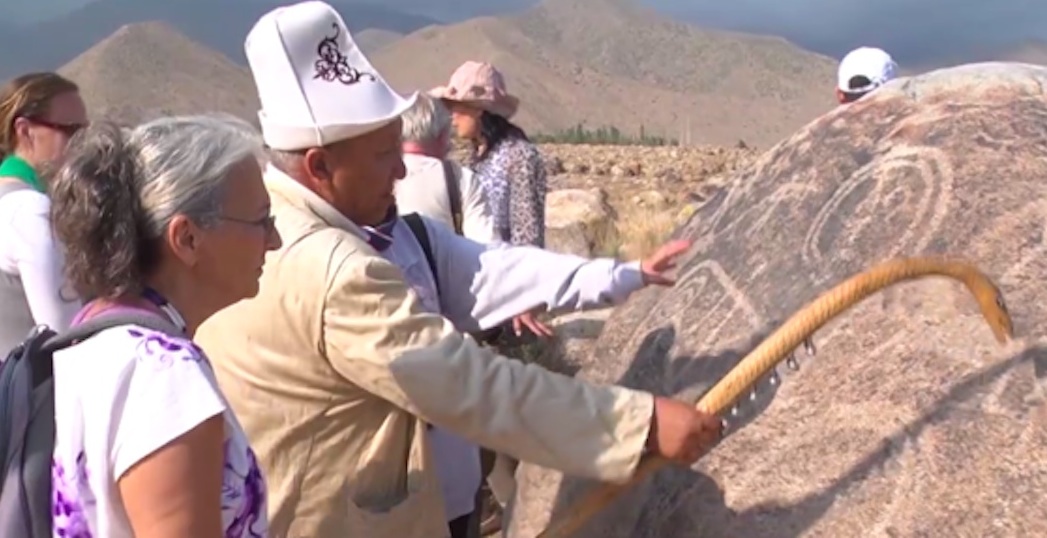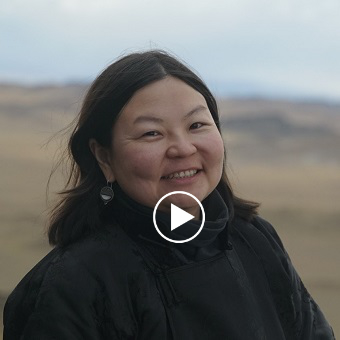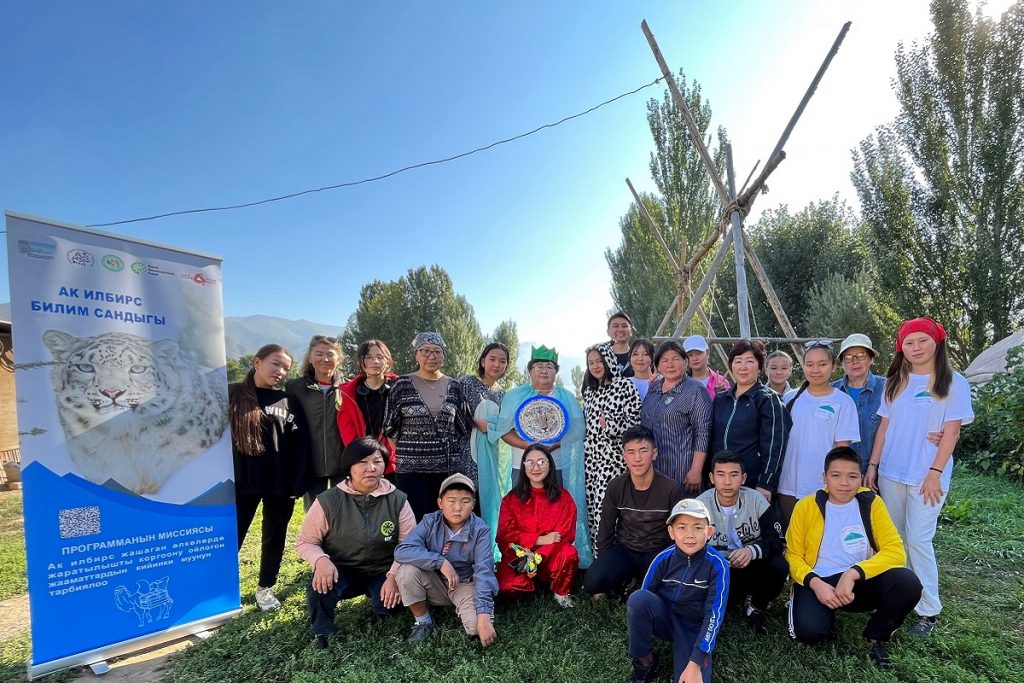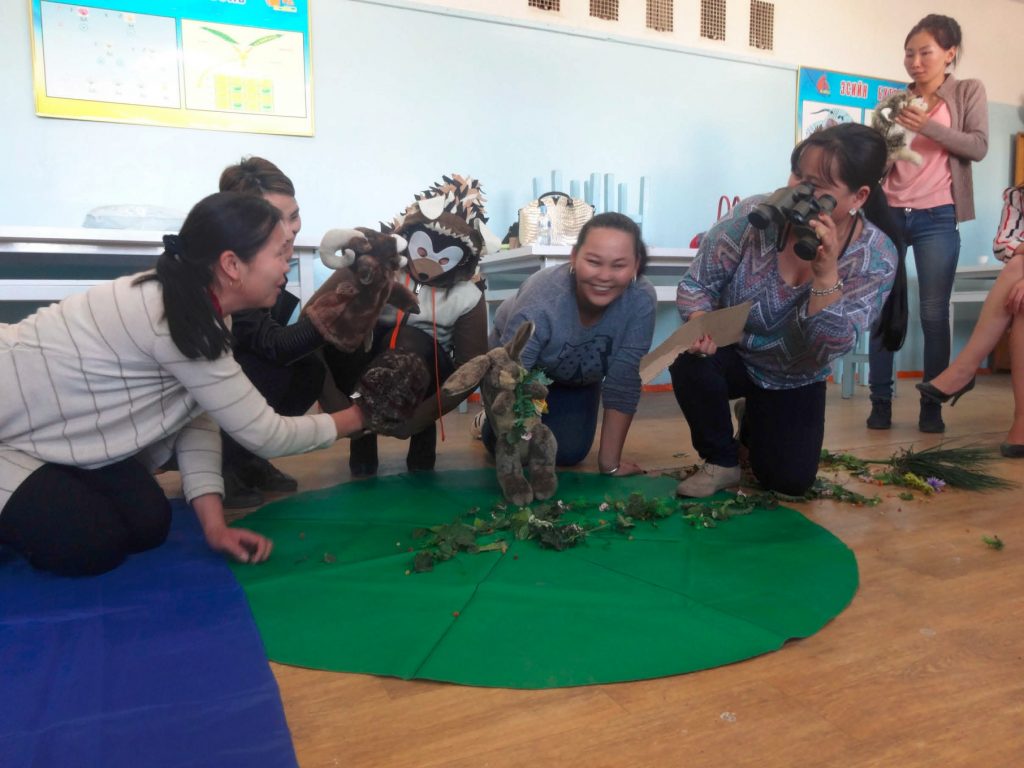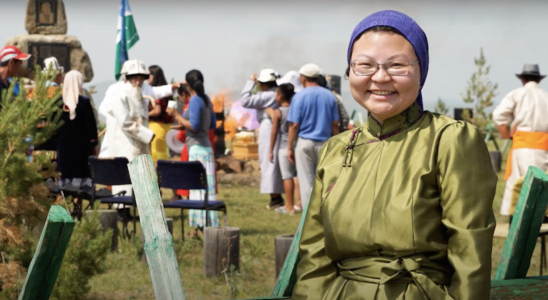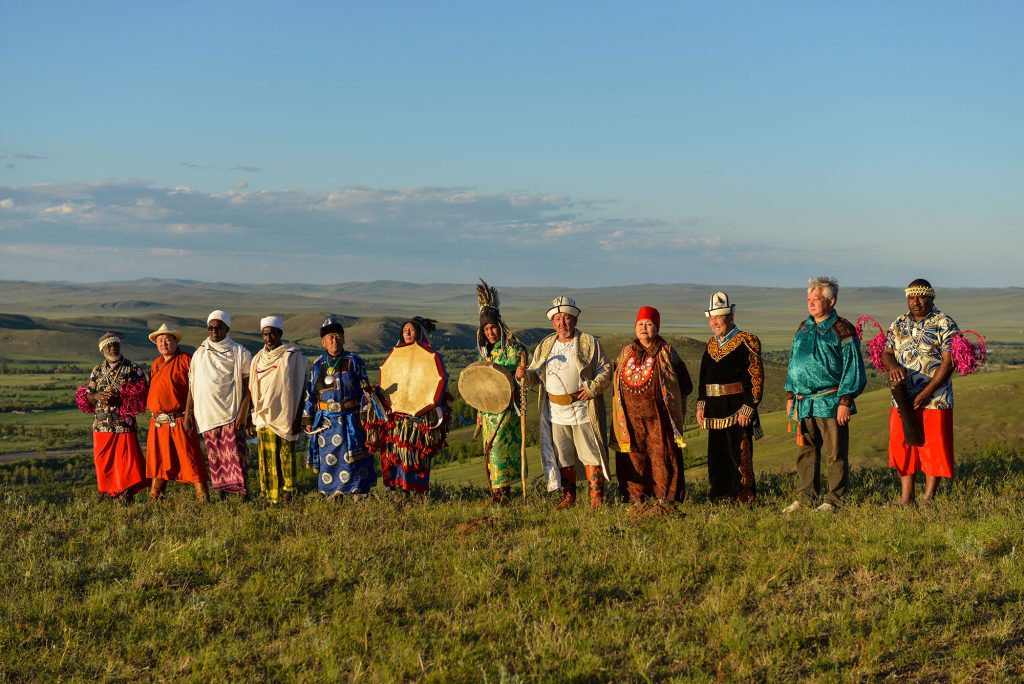
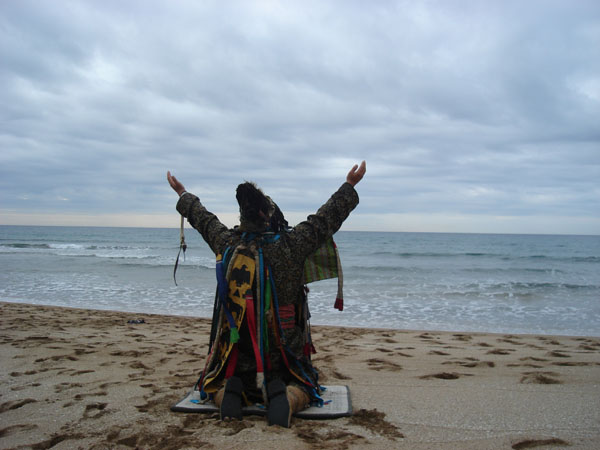
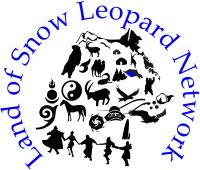 The Land of Snow Leopard (LOSL) Network, part of a groundbreaking collaboration between western and indigenous science, has two overriding goals: reviving ancient conservation practices and creating pathways for Indigenous Cultural Practitioners (ICPs) to be coequal partners in research and planning for the conservation of snow leopards.
The Land of Snow Leopard (LOSL) Network, part of a groundbreaking collaboration between western and indigenous science, has two overriding goals: reviving ancient conservation practices and creating pathways for Indigenous Cultural Practitioners (ICPs) to be coequal partners in research and planning for the conservation of snow leopards.
The catalyst for thie effort is the Global Snow Leopard Ecosystem Protection Program (GSLEP), whose leaders recognize that achieving the program’s objectives will require collective action, including the full participation of local communities.
The LOSL Network includes more than one hundred organizations and individuals. The founding members and network guides include shamans, sacred site guardians, and revered elders. These are referred to as Indigenous Cultural Practitioners: an ICP is defined as one who communicates with and receives support and guidance from the spirits/creator/ancestors/guardians.
Supporters of the LOSL Network include lifelong herders who know the ancient practices for reading and living in their environment; indigenous educators, historians, and traditional hunters striving to maintain or revive their cultres; program funders; and a handful of boots-on-the-ground natural scientists.
The network is striving to help the GSLEP governments understand and embrace the snow leopard’s spiritual nature and fundamental place in indigenous practices as well as to share knowledge of the spiritual and cultural importance of these cats and the imperative to embrace this knowledge in securing landscapes for their preservation.
The Land of Snow Leopard (LOSL) Network, part of a groundbreaking collaboration between western and indigenous science, has two overriding goals: reviving ancient conservation practices and creating pathways for Indigenous Cultural Practitioners (ICPs) to be coequal partners in research and planning for the conservation of snow leopards.
The catalyst for thie effort is the Global Snow Leopard Ecosystem Protection Program (GSLEP), whose leaders recognize that achieving the program’s objectives will require collective action, including the full participation of local communities.
The LOSL Network includes more than one hundred organizations and individuals. The founding members and network guides include shamans, sacred site guardians, and revered elders. These are referred to as Indigenous Cultural Practitioners: an ICP is defined as one who communicates with and receives support and guidance from the spirits/creator/ancestors/guardians.
Supporters of the LOSL Network include lifelong herders who know the ancient practices for reading and living in their environment; indigenous educators, historians, and traditional hunters striving to maintain or revive their cultres; program funders; and a handful of boots-on-the-ground natural scientists.
The network is striving to help the GSLEP governments understand and embrace the snow leopard’s spiritual nature and fundamental place in indigenous practices as well as to share knowledge of the spiritual and cultural importance of these cats and the imperative to embrace this knowledge in securing landscapes for their preservation.

The goals in our Land of Snow Leopard Network program are:
-
Merging western and indigenous approaches to scientific knowledge;
-
Establishing a precedent for Indigenous Cultural Practitioners (ICPs) to be co-equal partners in snow leopard conservation, standardize integration of relational world-views in such planning,
-
Revitalizing ancient ceremonies to remember and honor the snow leopard spirit as a unifier of humanity;
-
Establishing sacred sites as education/interpretive centers for the spiritual and terrestrial ecology of snow leopards;
-
Empowering cultural practitioners with new communication technologies, and building an on-line network.
Kyrgyz Legend of the Snow Leopard by Revered Elder Zhaparkul Raimbekov
The Snow Leopard Anthem by Qurbonidin Alamshoev
Snow Leopard Day Festival – Pamir Mountains of Tajikistan
The Land of Snow Leopard project is extremely inspiring, and particularly so for people working with carnivores in other cultural environments across the world. Involving all the different facets of local people from all walks of life to bring their own unique contributions to uplifting the landscape and habitat for people, livestock, and wildlife is a beautiful endeavour. And how you have done it – with singing, with myths, with science, with prayer, and with policy is a lesson to all of us around the world. You should all be very proud. We too don’t have a word for “conservation” in our language. Let it remain so. Conservation is part of everything we need to do every day. And in that way, we are all conservationists.
Resson Kantai Duff, Deputy Director, Ewaso Lions.
Ewaso Lions is an organization dedicated to promoting coexistence between people and lions in northern Kenya.
Nihizhi, Our Voices: An Indigenous Solutions Podcast
Protectors of the Snow Leopard: Maria Azhunova of the Buryat-Mongol Indigenous Peoples of the Russian Federation
In this podcast episode, host Lyla June talks with Maria Azhunova, Director of the Land of Snow Leopard (LOSL) Network. Their discussion focuses on the significance of the Snow Leopard, its meaning, and how LOSL is spreading awareness and education on this sacred animal, as well as protecting the animal from humans and outside dangers that can interfere with the endangered snow leopard, who lives in the mountains of South and Central Asia.
2022
IUCN Save Our Species Grant
The LOSL Network was a recipient of an IUCN Save Our Species grant which concluded in 2022. While LOSL’s program area also includes Mongolia, the IUCN Save Our Species project, entitled “Sustaining Indigenous Communities in Snow Leopard Conservation,” was specifically focused on expanding education projects in Kyrgyzstan and Tajikistan.
Elders and Youth for Conservation of the Snow Leopard
The IUCN grant fully supported this program in Kyrgyzstan, conceived of and executed by Zhaparkul Raimbekov, a founding member of LOSL and a Giver of Blessings throughout his community. The aim of this project is the strengthening of mutual understanding by the local population of the spiritual practices for the preservation of sacred animals and sacred places and the involvement of youth.
You can read more about the Elders and Youth Program here.
Expansion of the Nomadic Nature Trunk Program
Over the past year, the Nature Trunks Program expanded its reach in Mongolia from serving only rural schools to also encompassing the urban center of Ulaanbaatar where one-half of Mongolia’s population resides. Teacher-trainers were tasked with providing instructional methods for their colleagues while program facilitators ensured that lessons were properly conducted. With expansion into an urban area, we’re able to reach a greater number of children and their respective families, which in turn has a larger impact on snow leopard conservation through both individual and community action. Read More
In May, the Taalim Forum in partnership with the Rural Development Fund and funded by the IUCN SOS grant began expansion of the Nature Trunk Program into Kyrgyzstan. Training sessions were held in Bishkek for program coaches with the participation of teachers from four schools. The program consists of both scientific and traditional ecological knowledge of high mountain ecosystems, including lessons on biodiversity, protection of the environment, and the peaceful coexistence of man and nature. Students will develop teamwork skills, learn to analyze and draw conclusions, conduct field research, and actively participate in discussions. Utilizing materials from the Nature Trunk, lessons may be conducted both in the classroom and in the field.
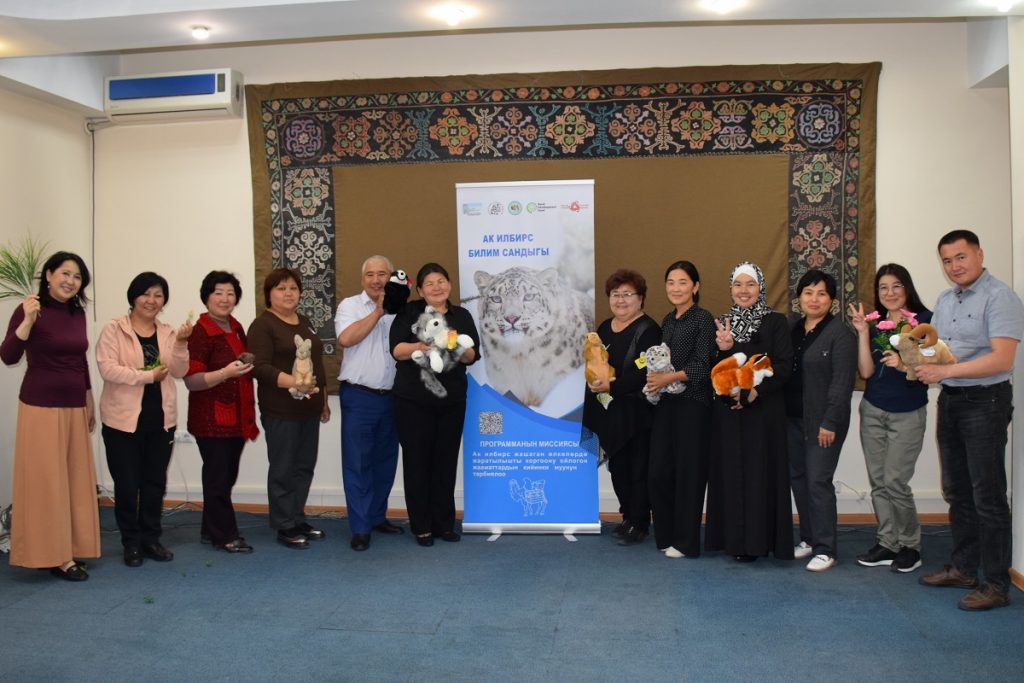
Nomadic Nature Trunk Teacher Training – Bishkek
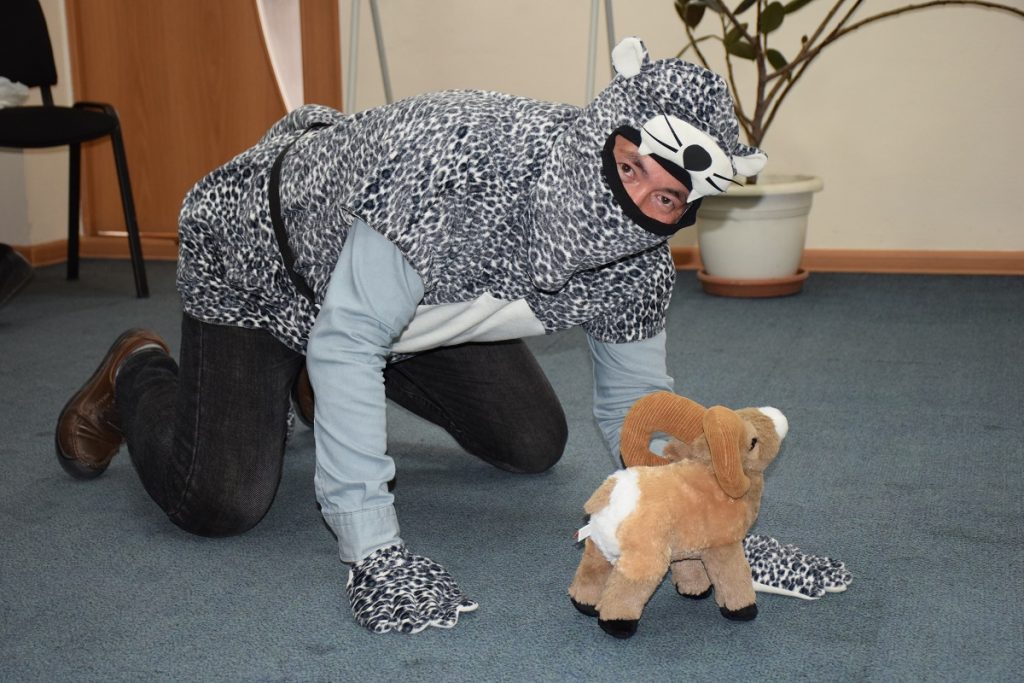
Nomadic Nature Trunk Teacher Training – Bishkek
Nomad Kids’ Camp
In August, under the auspices of LOSL and as part of the IUCN grant-funded expansion of the Nature Trunk program, the Taalim Forum and Rural Development Fund held an ethno-ecological ‘Nomad Kids’ Camp’ in the village of Shabdan, Kyrgyzstan. Eighteen schoolchildren participated as well as four of their classroom teachers. They learned about the snow leopard and its habitat, other species of wildlife and plant life within the ecosystem, and about conservation methods. Activities also explored the importance of preserving biocultural diversity by reconnecting with nature while “restoring balance and harmony, reviving the wisdom of the ancestors, and seeking ways for more sustainable development.”
You can read more about the camp here
2021
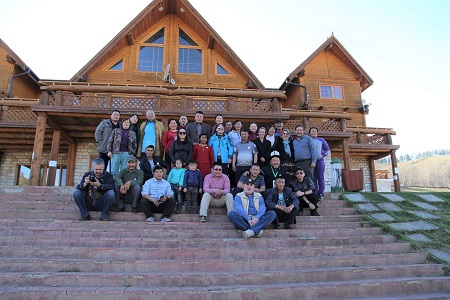
Land of Snow Leopard Network 2019 Gathering
Sonoma, California, United States, June 8, 2021 – Snow Leopard Conservancy announced today that Land of Snow Leopard Network has been honored with a Disney Conservation Hero Award. The award recognizes local citizens for their commitment to save wildlife, protect habitats, and inspire their communities to take part in conservation efforts. Recipients from around the world were nominated by nonprofit environmental organizations, and each honoree and their nominating organization will share a $1,500 award from the Disney Conservation Fund.
Land of Snow Leopard Network is one of only 20 award recipients in the 2020 cohort globally. Maria Azhunova, director-elect of LOSL told us that “Land of Snow Leopard Network (LOSL) members—local communities, herders, teachers, children, and Indigenous cultural practitioners from five regions of Central and Inner Asia—accepted the Disney Conservation Hero Award with big joy and deep gratitude.”
“Elders of our Network speak the language and know the magic of nature; they are real masters of science that Mr. Walt Disney once described as ‘a science, whose principles are written in the oldest codes of the world—Laws of Nature.’ LOSL works hard to integrate this knowledge into modern conservation efforts.
The Disney Conservation Hero Award honors our approach and gives us and our allies additional inspiration and hope that millions of Disney friends will also join our Network to save one of the most beautiful animals on earth—the snow leopard and its ecosystems. As Walt Disney used to say, ‘Conservation is not a business of just a few people. It is a matter that concerns all of us.’”
Disney Conservation is committed to saving wildlife and building a global community inspired to work together to protect the magic of nature. Since 1995, the Disney Conservation Fund has directed more than $100 million to support nonprofit organizations working with communities to save wildlife, inspire action, and protect the planet and has honored more than 200 Conservation Heroes for their extraordinary conservation efforts.
For information on Disney’s commitment to conservation and a complete list of recent Conservation Hero Award recipients, visit Disney.com/Conservation.
Almagul Osmonova, Land of Snow Leopard Network country coordinator for Kyrgyzstan, participated in the Local Hands roundtable discussion on behalf of the Conservancy at the WCN Wildlife Conservation Virtual Expo in April 2021. Together with her partners from other local NGOs, Ms. Osmonova works to protect snow leopards and their habitats by engaging local communities, teachers, and students in education and awareness-building activities.
With the moderation of Covid-19 restrictions in Mongolia, the Land of Snow Leopard Network recently was able to conduct virtual Nomadic Nature Trunk training. While LOSL’s education program area also includes Mongolia, our IUCN Save Our Species project, entitled Sustaining Indigenous Communities in Snow Leopard Conservation, is focused on expanding our education projects, including Nomadic Nature Trunks, into Kyrgyzstan and Tajikistan.
These traveling trunks contain a treasure trove of conservation lessons for students who live in remote mountain communities in the snow leopard’s range. From paw prints to pictures, through interactive games and lessons, students learn about the biodiversity of the local wildlife and how each species interacts with and contributes to the environment.
Increasing knowledge and developing awareness is imperative for the survival of the snow leopard which is listed as vulnerable on the IUCN Red List of Threatened Species.
2020
Maria Azhunova, director-elect of the Conservancy’s Land of Snow Leopard Network and executive director of the Baikal Buryat Center of Indigenous Cultures, was the 2020 recipient of Stanford’s Bright Environmental Award, which recognizes individuals who have made significant contributions in environmental preservation and sustainability from one of ten rotating regions, South Asia, the Middle East; West Asia; Africa; Europe; South America; and North America.
2019
In November of 2019, Marcia Sivek of BeProvided Conservation Radio interviewed Maria Azhunova, the newly elected leader of the Land of Snow Leopard Network, and Darla Hillard of the Snow Leopard Conservancy, facilitator for the network.
2018
The Land of the Snow Leopard (LOSL) Network completed its third year of a groundbreaking collaboration between Western and Indigenous science, with the goal of creating pathways for Indigenous people to be equal partners in research and planning for conservation of snow leopards.
In September, Rodney, Charleen, and Darla traveled to Bishkek, Kyrgyzstan, to meet with LOSL’s seven Country Coordinators and other key Network members in order to work through some challenges of communicating in more than five languages and working in remote, mountainous snow leopard habitat across Kyrgyzstan, Mongolia, and Tajikistan.
In the Network’s program areas, the snow leopard is not only a flagship species for biocultural diversity, it is the axis mundi of ancient traditions, legends, and beliefs. These beautiful, mysterious animals are protectors of sacred mountains, a unifying force, and a source of spiritual power and wisdom. Despite the remoteness of their high-mountain habitat, snow leopards are vulnerable to human-caused threats across a wide spectrum. Most of these cats roam outside the relative safety of national parks or other officially protected areas.
The LOSL network now includes over 100 organizations and individuals. The founding members include Shamans, Sacred Site Guardians, and revered Elders. They are referred to as Indigenous Cultural Practitioners (ICPs). An ICP is defined as “one who communicates with and receives support and guidance from the spirits/creator/ancestors/guardians.” While ICPs serve as guides, the greater LOSL community includes lifelong herders who know the ancient practices for reading and living in their environment, indigenous educators, historians, scientists, and traditional hunters.
The catalyst for this work is the Global Snow Leopard Ecosystem Protection Plan (GSLEP), whose leaders recognize that achieving the plan’s objectives will require collective action – including the full participation of local communities.
The strength of the LOSL Network is the knowledge and experience of the spiritual and cultural importance of Snow Leopards to the work of securing landscapes for their preservation. The challenge is to help the Snow Leopard range country governments understand and embrace the Spiritual nature of Snow Leopard and it’s fundamental place in indigenous practices and knowledge of how to protect the species.
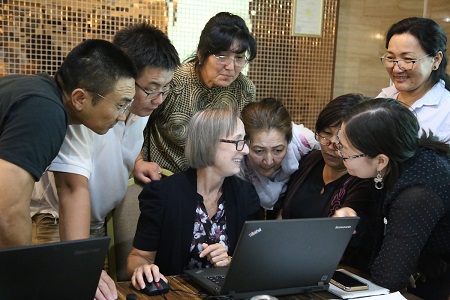
Over the past three years, the Network has made significant progress, in part through the creation of two database structures. One is a geospatial computer App for monitoring wildlife sightings, poaching incidents, and other data in a way that supports the goals of the GSLEP, including the overarching goal of “20 landscape-level snow leopard populations protected by the year 2020.”
Unique to this project is a platform that enables the members to collect interviews, stories, folklore, photos, and videos. Country Coordinators had collected a large amount of this culturally-important data, but they had encountered problems in getting the information onto the platform so it could be shared among the network members. Thus, the September meeting was called to deal with database management.
Once the technical problems were solved, a system and form for summarizing and categorizing photos, interviews, etc. that were considered of cultural and/or spiritual importance was developed. All summaries will be translated into Russian and English. This allows for easy sharing of the data, to identify commonalities, create reports, and develop tools for revival/preservation of traditional practices. No one has attempted this kind of effort before, to standardize the integration of culturally-important data into conservation planning and action for snow leopards.
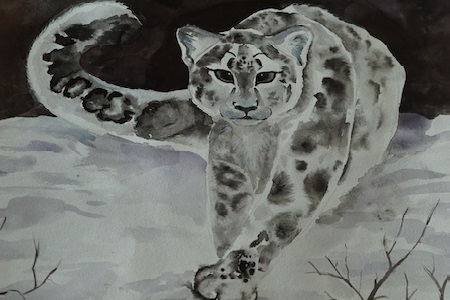
ICPs and other LOSL Network members are already developing tools and taking an active lead in reviving traditional practices that save snow leopards.
-
They are bringing new ways of learning about snow leopards to their local schools. In Russia’s Buryat Republic, the Baikal Buryat Center for Cultural Conservation followed the example of the Conservancy’s Mongolian partner, Nomadic Nature Trunks. They introduced interactive conservation education through visits to all the schools in Okinsky Region. A local Buddhist spiritual leader talked to students about the indigenous attitude towards nature and how to record observations using the LOSL snow leopard monitoring App. The children at one school decided to write special love letters to snow leopards.
-
In Mongolia, Shaman Buyanbadrakh led the effort to establish Spirit Lord of Sutai Mountain in his home province of Hovd. The mountain is now officially acknowledged as a spiritual and cultural sacred site of the Mongolian Altai.
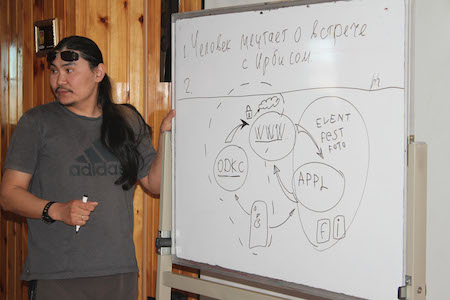
2017
After two years of effort, LOSL network member Association for Protection of Altai Cultural Heritage successfully established “Spirit Lord of Sutai Mountain” as intellectual property. Sutai Mountain, located in Khovd Province, stretches about 4090 meters) above sea level.
LOSL members from Kyrgyzstan and the Russian Altai Republic represented the network at the GSLEP Stocktaking and Steering Committee meetings held in Kathmandu, Nepal, in January.
Zhaparkul Raimbekov was invited by the UN and Kyrgyz Head to represent the Land of the Snow Leopard Network at a panel discussion in New York to mark International Snow Leopard Day, October 21, and to publicize the GSLEP.
Abdylkalyk Rustamov, Director of the Kyrgyz Agency on Environment Protection and Forestry stressed the importance of integrating climate-smart conservation efforts with the interests and needs of the local communities who share the snow leopard’s habitat.
In his closing blessing, Zhaparkul spoke of the inherent value and dignity of the snow leopard, and of the importance of mutual respect between all creatures.
2016
The Conservancy brought together 20 Indigenous Cultural Practitioners from Mongolia, Kyrgyzstan, Tajikistan, and the Altai and Buryat Republics of Russia for a ten-day workshop in Mongolia. We outlined ways to improve cultural components of education programs, and drafted the content for a custom computer Application (APP) to facilitate wildlife monitoring and data collection in a way that supports the needs of local communities as well as the goals of the Global Snow Leopard & Ecosystem Protection Plan (GSLEP).
The participants selected Land of the Snow Leopard as both the name for our network and its App. The App was translated into the five languages used by our Network members. Field testing and refinement of the Beta version of the App continued through the year in anticipation of the planned GSLEP Steering Committee meeting, which was postponed until January 2017.
2012-2013
The Kyrgyzstan Head of State initiated a Ministry-level effort to create a Global Snow Leopard Ecosystem Protection Plan (GSLEP). See Global Plan in our Conservation section for details. This effort presented the first-ever opportunity to directly involve ICPs in such high-level planning for conservation.
